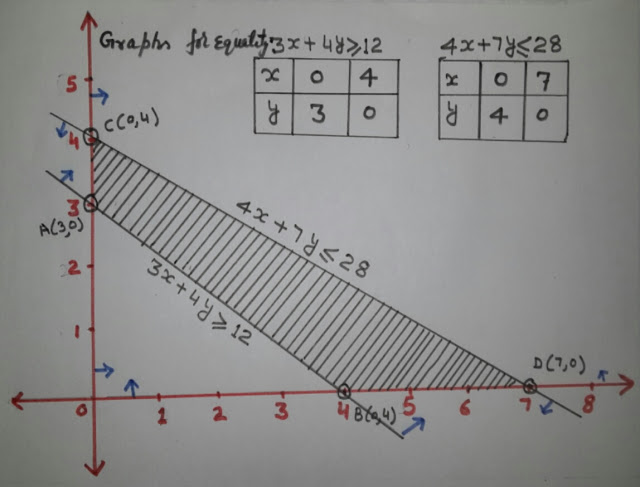HOW TO PROVE TRIGONOMETRIC IDENTITIES || TRIGONOMETRY
Proof of trigonometric identities , trigonometric identities problems, proving trigonometric identities formulas,these trigonometric identities of class 10, fundamental trigonometric identities,trigonometric identities class 11 and its formation with the help of some examples.
How to prove Identity
Proof
1st of all rewrite 3x as 3.2x
L.H.S. = cos 6x = cos (3.2x)
L.H.S. = cos 6x = cos (3.2x)
Now using the result cos 3θ = 4cos3 θ - 3 cos θ -----(1)
Replacing θ as 2x in (1), we get
L.H.S. = 4cos3 2x - 3 cos 2x -----------(2)
Now using the result 1+ cos 2θ = 2 cos2 θ
⇒ cos 2θ = 2 cos2 θ -1
L.H.S.= 4 {2cos2 x -1}3 - 3 {2 cos2 x -1}
Now using the result {a - b }3 = {a}3 - { b }3 - 3{a }2 .b + 3(a). b2
cos 6x = 4[ {2cos² x }3 - { 1 }3 - 3{2cos² x }2 .1 +3.(2cos² x) .1² ] - 3 . {2 cos² x -1}
Taking the product of powers to simplify it
cos 6x = 4[ 8cos⁶ x - 1 - 12cos⁴ x + 6cos² x] - 3{2cos² x-1}
Multiply by 4 in 1st term and multiply by -3 in 2nd term
cos 6x = 32cos⁶ x - 4 - 48cos⁴ x + 24cos² x - 6cos² x + 3
Adding the like powers terms and arranging in descending order
cos 6x = 32cos⁶ x - 48cos⁴ x + 18cos² x - 6cos² x - 1
Hence the Proof
Hence the Proof
Prove the Identity
tan (2x) = 2tan x 1 - tan2 x
Proof
We know that
tan (A+B) = tan A + tan B1 - tan A tan B
Put A = B = x in above formula . then it becomes
tan (x+x) = tan x + tan x1 - tan x tan x
tan (2x) = 2tan x 1 - tan² x
tan (x+x) = tan x + tan x1 - tan x tan x
tan (2x) = 2tan x 1 - tan² x
Hence the Proof
Prove that sin 2x = 2sin x cos x
Proof
As we know that sin (A + B) = sin A cos B + cos A sin B.. ...(1)
Put A = B = x in ... (1)
sin (x + x) = sin x cos x + cos x sin x
sin (2x) = sin x cos x + sin x cos x
sin (2x) = 2 sin x cos x
Hence the Proof
Prove that cos 2x = cos2 x - sin2 x
Proof
As we know that cos (A + B) = cos A cos B - sin A sin B.. ...(1)
cos (x + x) = cos x cos x - sin x sin x
cos 2x = cos2 x - sin2 x
Hence the Proof
Prove that cos 4x = 8 cos⁴ x - 8 cos² x + 1
Proof
Using the result
1+cos 2θ = 2cos2 θ
cos 2θ = 2cos2 θ -1 -------------(1)
Replacing θ with 2x in eq (1)
1+ cos 4x = 2cos2 2x
cos 4x = 2cos2 2x -1
Again using cos 2θ = 2cos2 θ -1
cos 4x = 2(2cos2 x -1)² -1
It is the square of 2cos2 x -1
cos 4x = 2(2cos2 x -1)² -1
cos 4x = 2(4cos4 x +1 - 4cos2 x) -1
cos 4x = 8cos4 x +2 - 8cos2 x -1
cos 4x = 8cos4 x - 8cos2 x +1
Hence the Proof
What is the value of sin3x?
To find the value of sin 3x , use this formula which contain sin (A+B)
therefore sin (A+B) = sin A cos B cos A sin B——-(1)
put A = 2x and B = x in (1)
then Sin 3x = sin 2x cos x + cos 2x sin x
As we know that cos 2x = 1 - 2sin³ x and sin 2x = 2 sin x cos x
Sin 3x = Sin (2x+x)
Sin 3x = sin 2x cos x + cos 2x sin x
sin 3x = (2 sin x cos x) cos x + (1 - 2sin³ x ) sin x
sin 3 x = 2 sin x cos² x + sin x - 2sin³ x
As we know that cos² x = 1- sin² x
sin 3x= 2 sin x (1-sin³ x) + sin x - 2sin³ x
sin 3x = 2 sin x -2 sin³ x + sin x - 2sin³ x
sin 3x = 3 sin x - 4 sin³ x
Similarly we can prove that cos 3x= 4 cos³ x - 3 cos x
For learning and memorising more trigonometric formulas
visit here for EASY TRIGONOMETRY PART 1
Conclusion
In this post I have discussed trigonometric identities ,trigonometric identities problems, proving trigonometric identities formulas . If this post helped you little bit, then please share it with your friends to benefit them, comment your views on it to boost me and to do better, and also follow me on my Blog .We shell meet in next post till then Bye
If you are a mathematician Don't forget to visit my Mathematics You tube channel ,Mathematics Website and Mathematics Facebook Page , whose links are given below














